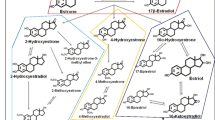Abstract
Oestrone sulphatase is an important source of local synthesis of biologically active oestrogens in human breast cancer. The oestrone sulphatase enzyme in the particulate fraction of human breast carcinoma was characterised. The Km was 8.91 microM, and the Vmax was 0.022 nmol min-1 mg-1. Oestrone sulphatase activity was detected in 93 of 104 human breast carcinoma samples (89%), and mean activity was 0.041 nmol min-1 mg-1 (range 0-0.399 nmol min-1 mg-1). There was no significant correlation between intratumoral oestrone sulphatase activity and oestrogen receptor status, or with any other prognostic factors. Intratumoral enzyme levels were not associated with time to recurrence or with overall survival time. It thus appears that, although a useful source of intratumoral oestrogens, oestrone sulphatase activity is not of prognostic significance in breast carcinoma.
Similar content being viewed by others
Author information
Authors and Affiliations
Rights and permissions
About this article
Cite this article
Evans, T., Rowlands, M., Law, M. et al. Intratumoral oestrone sulphatase activity as a prognostic marker in human breast carcinoma. Br J Cancer 69, 555–561 (1994). https://doi.org/10.1038/bjc.1994.101
Issue Date:
DOI: https://doi.org/10.1038/bjc.1994.101
- Springer Nature Limited
This article is cited by
-
In breast cancer subtypes steroid sulfatase (STS) is associated with less aggressive tumour characteristics
British Journal of Cancer (2018)
-
Serum estrone concentration, estrone sulfate/estrone ratio and BMI are associated with human epidermal growth factor receptor 2 and progesterone receptor status in postmenopausal primary breast cancer patients suffering invasive ductal carcinoma
SpringerPlus (2015)
-
Aromatase and steroid sulfatase mRNA expression in fine needle aspirates from benign and malignant breast disorders
Chinese Science Bulletin (2012)
-
Molecular therapy of breast cancer: progress and future directions
Nature Reviews Endocrinology (2010)
-
Efficacy of three potent steroid sulfatase inhibitors: pre-clinical investigations for their use in the treatment of hormone-dependent breast cancer
Breast Cancer Research and Treatment (2008)




